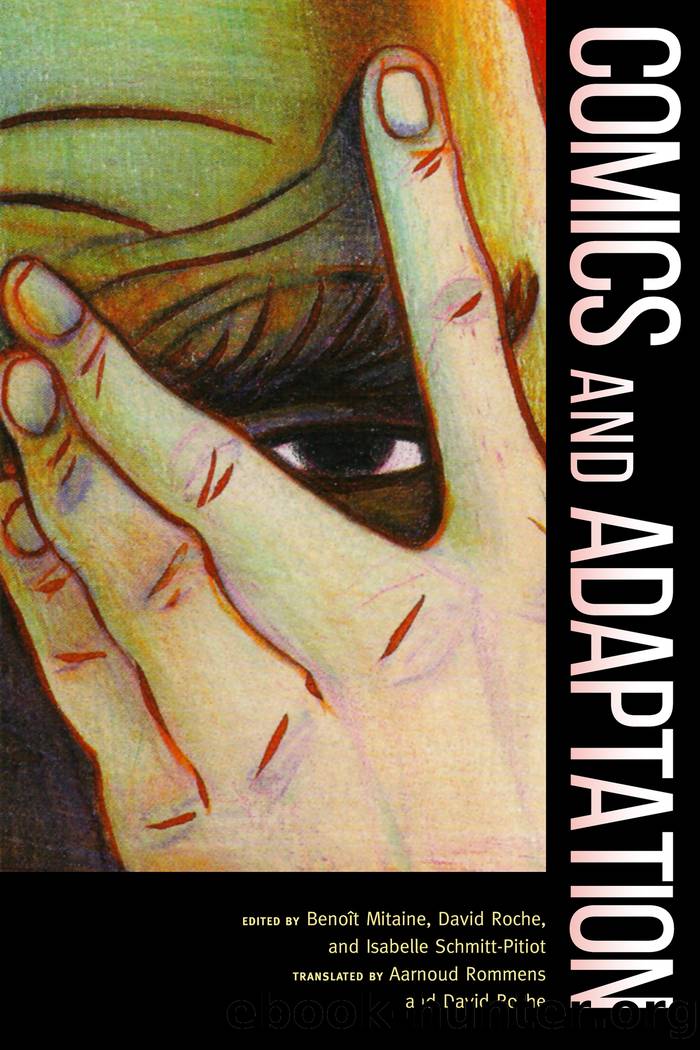Comics and Adaptation by Unknown

Author:Unknown
Language: eng
Format: epub
Publisher: University Press of Mississippi
Published: 2018-11-14T16:00:00+00:00
Fig. 22: El hombre descuadernado (Cava and Sanyú, 2009): a series of close-ups of the Horlaâs eyes, mouth, and hands.
The double-page spread, where the Horla is shown leaning over the shoulder of Maupassant at his desk holding a quill, brilliantly illustrates both the physical and mental influence of the double on the original. Besides the Horlaâs towering presence that domineers the writer, it is difficult not to link the Indian ink Maupassant uses to write his short story with the Horlaâs physical appearance, which is portrayed in thick black stripes resembling ink strokes. It is as if the Horla surfaced from the page itself, still dripping with the ink the author used to write this romantic being into existence. We are confronted with the familiar scenario of the mad scientist or divinely inspired writer, overwhelmed by the creature he has created.
In addition to the Horlaâs posture and physical appearance, Sanyúâs clever and original framing are especially noteworthy, both in this excerpt and throughout the comic. Emphasizing body parts through extreme close-ups effectively emphasizes the evil and monstrous aspect of this otherworldly being; this malevolent eye can only inspire fear (fig. 22), like the close-up of the hand which simultaneously refers to the hand of the strangler and to the monstrous fantasy of the severed limb that seems to have a will of its own. This streaked, clenched, and flayed hand23 is no longer human; it is at best animal, at worst supernatural or extraterrestrial.
By entitling this chapter âMaupassant and Maupassant,â Cava goes beyond mere adaptation and proposes a psychoanalytic reading of the âHorla.â Like others before him, he suggests that this hallucinatory tale owes as much to the authorâs madness as to his imagination. Throughout the remaining fifteen chapters, Cava continues to blend the story of the âHorlaâ with Maupassantâs life, taking the reader through each phase of the authorâs madness up until the final page, which shows a realistic representation of the tomb at the Montparnasse cemetery where the author was laid to rest.
Though more can be said of Cavaâs script, it is now necessary to turn to the artwork, which, from beginning to end, is affected by the madness and suffering of the central character. The Argentine artistâs graphic adaptation is twofold, as he simultaneously interprets the Horla and Cavaâs script; it is enigmatic and often makes the reader think the drawings could only have been the work of a madman. If indeed it seems crazy, it is only in the sense that Sanyú has devoted an insane amount of time to the workâfive years of his life, in fact (admittedly, he was simultaneously working on other projects).
Download
This site does not store any files on its server. We only index and link to content provided by other sites. Please contact the content providers to delete copyright contents if any and email us, we'll remove relevant links or contents immediately.
Kathy Andrews Collection by Kathy Andrews(11765)
The remains of the day by Kazuo Ishiguro(8887)
Spare by Prince Harry The Duke of Sussex(5138)
Paper Towns by Green John(5136)
The Body: A Guide for Occupants by Bill Bryson(5027)
Industrial Automation from Scratch: A hands-on guide to using sensors, actuators, PLCs, HMIs, and SCADA to automate industrial processes by Olushola Akande(5024)
Machine Learning at Scale with H2O by Gregory Keys | David Whiting(4258)
Be in a Treehouse by Pete Nelson(3996)
Never by Ken Follett(3880)
Harry Potter and the Goblet Of Fire by J.K. Rowling(3808)
Goodbye Paradise(3761)
Into Thin Air by Jon Krakauer(3347)
The Remains of the Day by Kazuo Ishiguro(3345)
Fairy Tale by Stephen King(3307)
The Cellar by Natasha Preston(3296)
The Genius of Japanese Carpentry by Azby Brown(3254)
120 Days of Sodom by Marquis de Sade(3225)
The Man Who Died Twice by Richard Osman(3040)
Drawing Shortcuts: Developing Quick Drawing Skills Using Today's Technology by Leggitt Jim(3037)
